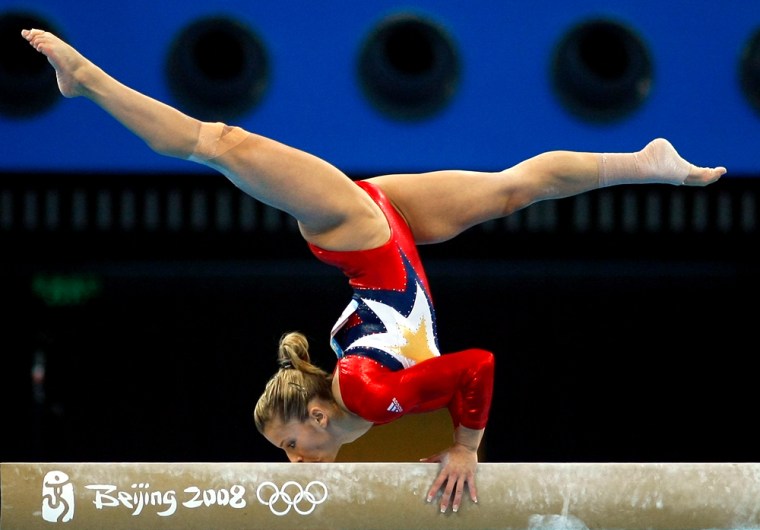When one thinks of a defining moment from the 1996 Olympics in Atlanta, the image of Kerri Strug leaps to mind.
The 4-foot-9, 87-pound teenager fell while competing in the vault event, hurting her ankle in the process. Yet, limping and all, she attempted another vault, collapsed afterward as her ankle gave way and notched a 9.712 score. The U.S. team captured the gold medal, and a smiling Strug was carried around the mat by her coach, Bela Karolyi. Soon she appeared on the cover of Sports Illustrated, as a guest host on “Saturday Night Live” and in ad campaigns.
Every four years, after being ignored by the masses since the previous Olympics, gymnastics grabs the limelight. Whereas once track and field seemed to provide the majority of timeless Olympic moments — think of Jesse Owens in Berlin, or Rafer Johnson in Rome — gymnastics has leapt ahead. Olga Korbut's grin and mind-numbing flexibility was an iconic moment of the 1972 Olympics (along with Mark Spitz' seven gold medals), Nadia Comaneci — all of 14 — earned the first perfect 10 from judges in Montreal (where the scoreboards didn’t even go up that high), and Mary Lou Retton captured the hearts of millions in her home country in 1984 before gracing the side of a Wheaties Box.
But these examples beg the question: Why does the iconic moment of the Olympic Games always seem to end up being a high school girl flipping about bars and prancing around a floor mat? (One may also ask: Why does every coach seem to be a paunchy male who has a vague resemblance to Lech Walesa, the former president of Poland?)
One reason for gymnastics' quadrennial success: It's good television. There's quite a bit of dance in the floor exercise; the moves on the uneven bars can be breathtaking; and on the balance beam, young women can place their chins on the brown covering and contort their bodies in ways many can't imagine, much less match. They offer a bubbly smile that's more appealing to watch than, say, a dour weightlifter. And with about half the Olympic viewers female — an unheard of percentage during regular sports events — the popularity of gymnastics soars even higher.
Personal stories of these pixies (who are often the female equivalent, in height and weight, of jockeys) always seem compelling. Consider Retton, a 16-year-old from West Virginia who took up gymnastics because of the excitement of watching Romanian gymnast Comaneci as a girl. After birth she suffered from hip dysplasia and she had to overcome a knee injury before the Games, yet by the end Retton was arguably the most famous woman in America.
In an Olympic sport such as basketball, the lion's share of sports fans want to watch the men rather than the women. Their games are likely more popular because of a higher skill level and because they're played by superstars whose names are recognized by millions. In gymnastics, both the women and the men are often equally unknown at the outset, and the women's performances are more captivating to watch than men's. Seeing men whip around a pommel horse is mildly entertaining, but it doesn't beguile a nation. In fact, aside from Kurt Thomas, it's hard to name one well-known American gymnast of the last century.
Of course, not all is perfect. In a recent "Real World" segment on HBO, Bryant Gumbel spoke with Dominique Moceanu, a member of "The Magnificent 7" who won a gold medal during the Atlanta Olympics. She complained about the diet restrictions imposed on gymnasts at a young age and the stresses she encountered that led to injuries. And the pressure to perform in front of a global television audience before a gymnast has even attended her high school prom may be too much to place on any athlete.
Regardless, female gymnasts are often championed by marketers. The post-Olympics success of the Mary Lou Rettons and Kerri Strugs of the world are well documented. This year, Nastia Liukin — whose father was an Olympic gold medalist and who has appeared on TODAY — and Alicia Sacramone, who’s already inked a pact with CoverGirl, are positioned to attract a slew of offers after the Games.
So once again, America's attention turns to a sport featuring tiny athletes maneuvering about apparatuses that are hidden from the world except during the Olympics. This month, female gymnasts will be a huge topic of conversation; by Labor Day, save for the endorsement winners, gymnastics again will enter its four-year stretch in the wilderness.
